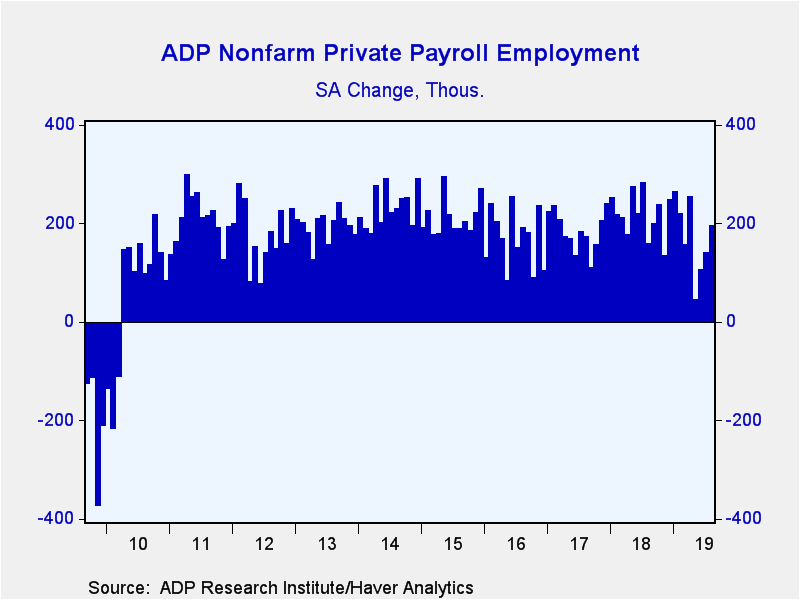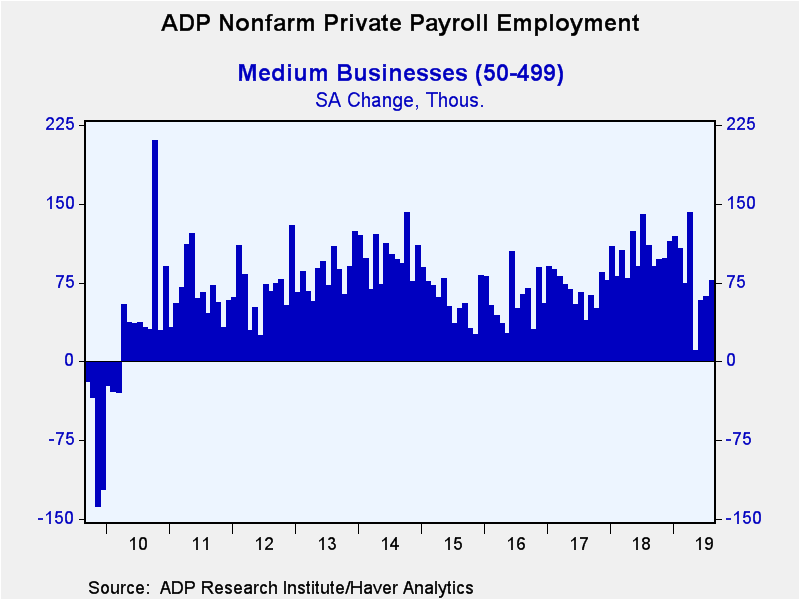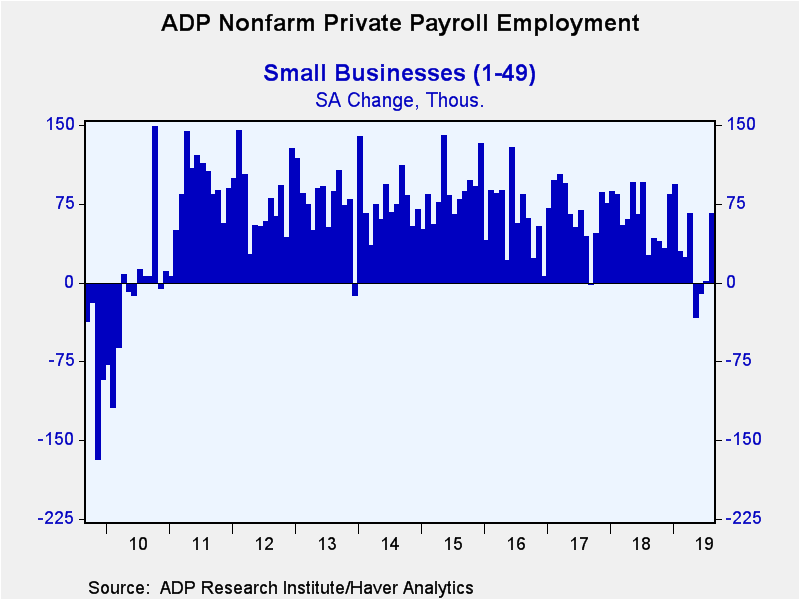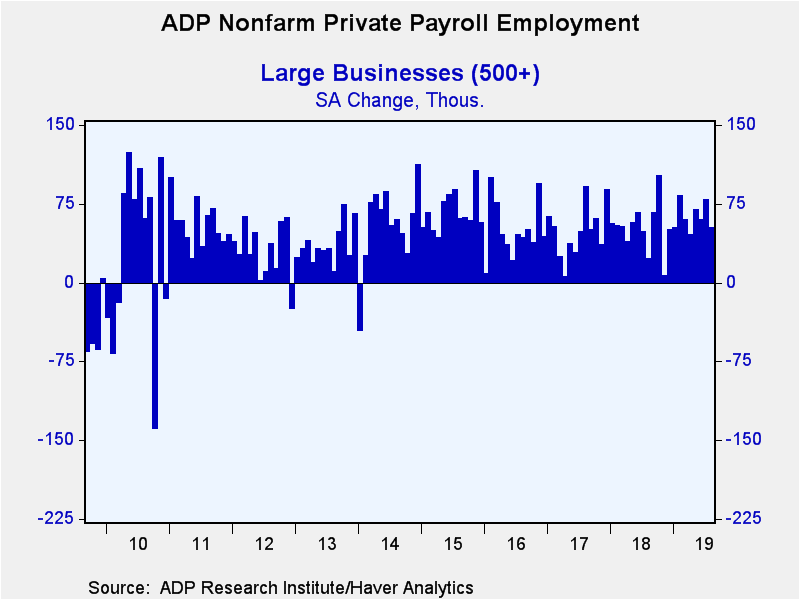 Global| Sep 05 2019
Global| Sep 05 2019U.S. ADP Private Payrolls Show Unexpected Strength
by:Tom Moeller
|in:Economy in Brief
Summary
Hiring in the private sector accelerated last month. The ADP National Employment Report indicated that private nonfarm payrolls increased 195,000 (1.7% y/y) during August following a 142,000 July gain, revised from 156,000. Payrolls [...]
Hiring in the private sector accelerated last month. The ADP National Employment Report indicated that private nonfarm payrolls increased 195,000 (1.7% y/y) during August following a 142,000 July gain, revised from 156,000. Payrolls increased 107,000 during June, revised from 112,000. A 150,000 increase had been expected in the Action Economics Forecast Survey. ADP payrolls have grown an average of 173,000 per month so far this year compared to a 219,000 monthly average in 2018. During the last ten years, there has been a 79% correlation between the change in the ADP figure and the change in nonfarm private-sector payrolls as measured by the Bureau of Labor Statistics.
Small-sized business led the overall August rise with a 66,000 gain (0.8% y/y), following a 1,000 uptick during July and declines during the prior two months. Medium-sized payrolls showed a 77,000 improvement (2.3% y/y) after a 62,000 July gain. It was the largest improvement since April. Large-sized payrolls rose 52,000 (2.5% y/y), the weakest increase in four months.
Private service-sector payrolls strengthened 184,000 (1.8% y/y) last month, up from 141,000 in July and a weak May increase of 68,000. Jobs in education & health services rose a fairly steady 58,000 (2.5% y/y). Leisure & hospitality jobs strengthened an improved 42,000 (2.2% y/y). Jobs in trade, transportation & utilities rose 39,000 (1.0% y/y). It was the strongest increase since October 2018 and up from a slight decline during May. Professional & business services hiring improved 35,000 (2.4% y/y) after a 33,000 rise. These increases were up sharply from those in the prior two months. Financial activities employment rose a lessened 5,000 (1.3% y/y), the weakest gain since March. These increases were countered by a 6,000 worker shortfall (-0.1% y/y) in information sector payrolls, which was the fourth consecutive monthly decline.
Employment in the goods-producing sector improved 11,000 (1.4% y/y) in August after a 1,000 July increase and two consecutive months of decline. Manufacturing sector employment improved 8,000 (0.8% y/y), the largest increase in six months. Construction sector payrolls rose 6,000 (2.8% y/y), but that was down sharply versus a 62,000 jump during January. Lower oil prices continued to weigh on hiring in the natural resource & mining sector where payrolls declined 2,000 (-1.1% y/y). Payrolls have declined for five straight months and were sharply below the 2014 high.
The Automatic Data Processing Research Institute survey is based on ADP's business payroll transaction system covering 411,000 companies and nearly 24 million employees. The data are processed by Moody's Analytics Inc., then calibrated and aligned with the BLS establishment survey data. The ADP data cover private sector employment only.
The ADP National Employment Report data can be found in Haver's USECON database. Historical figures date back to 2001 for private employment and the industry breakdown, and 2005 for the business size breakout. The expectation figure is available in Haver's AS1REPNA database.
| ADP/Moody's National Employment Report | Aug | Jul | Jun | Aug Y/Y | 2018 | 2017 | 2016 |
|---|---|---|---|---|---|---|---|
| Nonfarm Private Payroll Employment (m/m chg, 000s) | 195 | 142 | 107 | 1.7 | 2.0 | 1.7 | 2.0 |
| Small Payroll (1-49) | 66 | 1 | -11 | 0.8 | 1.5 | 1.5 | 1.9 |
| Medium Payroll (50-499) | 77 | 62 | 58 | 2.3 | 2.3 | 1.8 | 1.5 |
| Large Payroll (>500) | 52 | 79 | 60 | 2.5 | 2.3 | 2.1 | 2.7 |
| Goods-Producing | 11 | 1 | -7 | 1.4 | 3.1 | 1.7 | 0.8 |
| Construction | 6 | 12 | -5 | 2.8 | 5.0 | 3.3 | 4.3 |
| Manufacturing | 8 | -4 | 1 | 0.8 | 1.8 | 0.8 | 0.1 |
| Service-Producing | 184 | 141 | 114 | 1.8 | 1.7 | 1.8 | 2.2 |
Tom Moeller
AuthorMore in Author Profile »Prior to joining Haver Analytics in 2000, Mr. Moeller worked as the Economist at Chancellor Capital Management from 1985 to 1999. There, he developed comprehensive economic forecasts and interpreted economic data for equity and fixed income portfolio managers. Also at Chancellor, Mr. Moeller worked as an equity analyst and was responsible for researching and rating companies in the economically sensitive automobile and housing industries for investment in Chancellor’s equity portfolio. Prior to joining Chancellor, Mr. Moeller was an Economist at Citibank from 1979 to 1984. He also analyzed pricing behavior in the metals industry for the Council on Wage and Price Stability in Washington, D.C. In 1999, Mr. Moeller received the award for most accurate forecast from the Forecasters' Club of New York. From 1990 to 1992 he was President of the New York Association for Business Economists. Mr. Moeller earned an M.B.A. in Finance from Fordham University, where he graduated in 1987. He holds a Bachelor of Arts in Economics from George Washington University.










